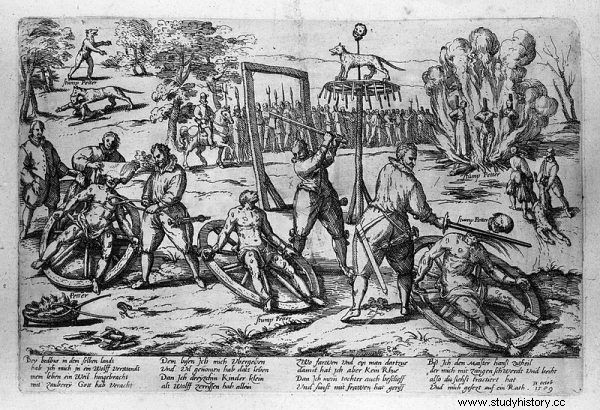Of all the characters involved in the course of the early-modern court trial, none today arouses such great fascination and stimulates the imagination as powerfully as the executioner - the perpetrator, who, insensitive to the pain of others, ruthlessly tortured the accused before the court, and after recovering from pleaded guilty, he executed their sentence with all severity. But was it really so?
Without the executioner, it is impossible to imagine the functioning of the medieval and early modern judiciary. It was indispensable for city authorities not only in order to execute their judgments. His unique abilities were already used at the trial stage, when by torture he forced statements from particularly dangerous criminals about the details of their crimes . In many countries of Western Europe (including France or the Holy Roman Empire), this made the executioner a person with a rather gloomy fame, but endowed with a lot of recognition and respect . In the Netherlands or in Silesia, whole families functioned, from generation to generation passing on the secrets of the executioner profession, which earned considerable fortunes in this profession. In some German states, an executioner with adequate seniority could even receive a knighthood .

The death penalty by beheading
Ostracism?
Contrary to the West, in Polish society the executioner was never particularly respected and contact with him for centuries was considered disgraceful: was disgusted with the human blood with which he constantly dealt, and it was also despised for contact with dead bodies . In order to avoid the risk of being in close proximity to the "little master" (not to mention direct physical contact with him!), Various systems of exclusion were applied to him. In some cities, bakers put bread aside for the executioner, turning it over, so that no bystanders accidentally touched the loaf previously held by the city torturer. In the tavern, he usually sat alone, at an empty table . Although some statutes of Polish cities gave him the privilege of sitting in a church in a separate pew reserved especially for him, the same mechanism of exclusion was hidden under the pretense of honor, primarily intended to protect other people from the proximity of the executioner.
Profitable career?
This form of isolation, however, often did not disturb the people involved in this activity. Sometimes it even turned out to be salutary. Why? They came from environments where a good name meant little anyway. Due to the enormous social ostracism towards this function and basically zero chances of finding a potential candidate for a "poor master" among honest people, the authorities of individual cities most often recruited new executioners from the group of criminals who were already sentenced to death . For a criminal who miraculously saved his head, the prospect of having his own home and permanent, well-paid orders from local authorities often turned out to be an unexpected improvement in the financial situation. Additionally, there were no sacrifices associated with it. In practice, the newly appointed executioner continued to be secretly in the same company of robbers, thieves and illegal prostitutes what so far. And if you add to this the fact that in most Polish cities his competences also included management of legal forms of prostitution (and reaping financial benefits from them!), for many, the new profession became quite a tolerable, and even attractive, way of life.

Various types of torture were used in the Middle Ages and the early modern age
As you can guess, however, all this created inevitable conflicts of interest . The city torturer earned extra money at night - as he and his friends used to rob houses. Some of them were later brought to trial, and the executioner was often reluctant to use particularly sophisticated torture against them. There were also cases when the executioner whipped an illegally prostituted woman under the pillory only to be offered a job in a local brothel (brothel), or when robbers questioned by judges directly admitted that " liquefied their spoils at the local torturer.
Even so, the executioner was rarely held accountable for his "extra-curricular" activities . As long as his romance with the criminal world did not end with committing one of the most severely punished crimes (eg murder or severe mutilation of a man), the city authorities preferred to turn a blind eye to what the "poor master" was doing after hours. Despite the already very low expectations of a potential candidate, finding a new kata was not an easy task at all. While cities such as Poznań or Kraków, which are (by Polish standards) large and dynamically developing centers, did not have any major problems in this respect, for example the authorities in Lublin were forced to rent it from others, sometimes remote towns, which, of course, involved additional costs.
Due to the length of the article, I omitted what may be the most interesting for many, namely the topic of torture itself used by city executioners - it will be the subject of the next text.
Bibliography:
1. Kaczor D., "Criminal crime and justice in Gdańsk in the 16th-18th centuries", Gdańsk 2005;
2. Kamler M., "The role of torture in the Polish municipal judiciary in the second half of the 16th and first half of the 17th century", 3/1988, pp. 109-125;
3. Kamler M., "The criminal world in Poland of the sixteenth and seventeenth centuries", Warsaw 1991;
4. Mikołajczyk M., "Criminal trial in the cities of Małopolska in the 16th-18th centuries", Katowice 2013;
5. Rosa W., "On the side of criminals or law enforcement services, i.e. the place of the executioner in the justice system in former Poland", Studies in the history of the state and Polish law 19/2016, pp. 69-80.
